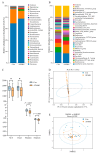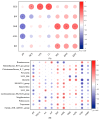Effects of Compound Microecological Preparation Supplementation on Production Performance and Nutrient Apparent Digestibility in Hu Sheep from the Rumen Perspective
- PMID: 40431172
- PMCID: PMC12114592
- DOI: 10.3390/microorganisms13050999
Effects of Compound Microecological Preparation Supplementation on Production Performance and Nutrient Apparent Digestibility in Hu Sheep from the Rumen Perspective
Abstract
This study evaluates the effects of a compound microecological preparation named ATABG, which is composed of antimicrobial peptide ID13 and Saccharomyces boulardii, on Hu sheep's growth performance, feed digestibility, and rumen parameters. A total of 40 three-month-old Hu sheep (21.65 ± 0.33 kg) were randomly assigned to two groups: the control group (Con), which received a basal diet, and the experimental group (ATABG), which received the same diet supplemented with 1 g/kg ATABG on a dry matter basis. After a 10-day pre-feeding period to adapt the animals to the experimental diet, dry matter intake and weight gain were recorded during the subsequent 63-day trial period. Body weight was measured on days 1, 21, 42, and 63 of the trial, and animals were slaughtered on day 63 to collect rumen fluid and tissue. Results indicated that ATABG supplementation significantly increased the apparent digestibility of crude protein, neutral detergent fiber, acid detergent fiber, and organic matter (p < 0.05). Rumen fluid analysis revealed increased microbial protein concentration and cellulase activity (p < 0.05) in the ATABG group. Microbiota analysis indicated that ATABG increased the relative abundance of Ruminococcus and Proteobacteria, elevated Firmicutes, and reduced Bacteroidota (p < 0.05). Correlation analysis showed Ruminococcus was positively associated with crude protein digestibility, while Quinella correlated with growth-related indices (r > 0.4, p < 0.05). In conclusion, ATABG supplementation improves protein digestibility and rumen microbial protein synthesis by enriching Ruminococcus and enhancing cellulase activity, potentially optimizing nitrogen utilization in Hu sheep.
Keywords: Ruminococcus; Saccharomyces boulardii; antimicrobial peptides; enzyme activity; rumen microorganisms.
Conflict of interest statement
The authors declare no conflicts of interest.
Figures






Similar articles
-
Effects of dietary forage neutral detergent fiber and rumen degradable starch ratios on chewing activity, ruminal fermentation, ruminal microbes and nutrient digestibility of Hu sheep fed a pelleted total mixed ration.J Anim Sci. 2024 Jan 3;102:skae100. doi: 10.1093/jas/skae100. J Anim Sci. 2024. PMID: 38581217 Free PMC article.
-
Effects of ensiling sugarcane tops with bacteria-enzyme inoculants on growth performance, nutrient digestibility, and the associated rumen microbiome in beef cattle.J Anim Sci. 2023 Jan 3;101:skad326. doi: 10.1093/jas/skad326. J Anim Sci. 2023. PMID: 37813104 Free PMC article.
-
Effects of dietary addition of ellagic acid on rumen metabolism, nutrient apparent digestibility, and growth performance in Kazakh sheep.Front Vet Sci. 2024 Feb 6;11:1334026. doi: 10.3389/fvets.2024.1334026. eCollection 2024. Front Vet Sci. 2024. PMID: 38379922 Free PMC article.
-
Glutamate Supplementation Improves Growth Performance, Rumen Fermentation, and Serum Metabolites in Heat-Stressed Hu Sheep.Front Nutr. 2022 Apr 6;9:851386. doi: 10.3389/fnut.2022.851386. eCollection 2022. Front Nutr. 2022. PMID: 35464012 Free PMC article.
-
3-Nitrooxypropanol supplementation of a forage diet decreased enteric methane emissions from beef cattle without affecting feed intake and apparent total-tract digestibility.J Anim Sci. 2023 Jan 3;101:skad001. doi: 10.1093/jas/skad001. J Anim Sci. 2023. PMID: 36617172 Free PMC article.
Cited by
-
Multi-Omics Integration Reveals the Impact of Gastrointestinal Microbiota on Feed Efficiency in Tan Sheep.Microorganisms. 2025 Jul 8;13(7):1608. doi: 10.3390/microorganisms13071608. Microorganisms. 2025. PMID: 40732118 Free PMC article.
References
Grants and funding
LinkOut - more resources
Full Text Sources

